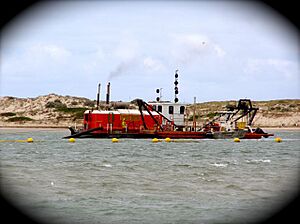Murray Mouth facts for kids
Quick facts for kids Murray mouth |
|
|---|---|

The narrow Murray Mouth in the background as viewed from Hindmarsh Island, November 2006
|
|
| Lua error in Module:Location_map at line 420: attempt to index field 'wikibase' (a nil value). | |
| Location | Australia |
| River sources | Murray River |
| Basin countries | Australia |
| Average depth | 2.4 m (7.9 ft) as of 1985 |
The Murray Mouth is where Australia's longest river, the Murray River, finally meets the big Southern Ocean. It's a really important spot for the river's health. The mouth doesn't stay in one place; it can move around over time. This happens because the river's flow and the ocean's waves can carve out new paths through the sand. When a new path forms, the old one often fills up with sand and disappears.
Contents
What is the Murray Mouth?
The Murray Mouth is found about 10 kilometers (6 miles) south-east of Goolwa. It's also about 75 kilometers (47 miles) south-east of Adelaide. It's basically a gap in the sandy coastal dunes. These dunes separate the river system from the ocean.
The mouth splits the dunes into two long pieces of land, like fingers pointing out. On the west side is Sir Richard Peninsula. It ends at a spot called Pullen Spit. On the east side is Younghusband Peninsula. It ends at a spot sometimes called Sleepy Hollow.
Water flows into the mouth from two main directions. From the west, water comes through a passage called the Goolwa Channel. This channel is next to Hindmarsh Island. From the east, water flows along the Coorong Channel. The Coorong Channel gets its water from other channels, like the Mundoo Channel and the Tauwitchere Channel.
How the Murray Mouth Formed
Millions of years ago, the Murray River didn't flow to the ocean like it does now. Instead, it ended in a huge freshwater lake called Lake Bungunnia. This lake covered a large area, including parts of what is now South Australia and New South Wales.
Less than a million years ago, the lake dried up. This is when the Murray River started flowing in its current path towards the ocean. Scientists have studied the land to understand how the river changed over such a long time.
History of Use
In the early 1800s, explorers like Charles Sturt discovered the Murray River. They found that the mouth was very tricky for ships to use. It had shallow areas and changing currents, making it hard to sail through.
Later in the 1800s, the river became very important for trade. Gold was discovered, and farmers grew sheep and wheat along the river. Boats carried goods and produce up and down the river. But the Murray Mouth was always a big problem. Many ships got stuck or wrecked there because of the difficult conditions. It was a dangerous place for river traffic.
Why Water Flow Matters

The water from the Murray River is used a lot. Farmers use it to water their crops in four different Australian states. Many towns along the river also get their drinking water from it. This water is even sent to places further away through long pipes.
Because so much water is taken from the river, there isn't always enough left to reach the mouth. This can cause the Murray Mouth to close up with sand. If the mouth closes, fresh seawater can't get into the Coorong, which is a nearby lagoon system. If this happens, the Coorong's water can get warm, stop moving, and harm the plants and animals that live there.
To keep the mouth open, special machines called dredges have been used. From 2002 to 2010, these machines worked almost all the time. They moved sand away from the channel to make sure water could still flow between the river and the sea. This helped keep the Coorong healthy. Dredging was planned to start again in 2015 to continue keeping the mouth open.
Protecting the Murray Mouth
The Murray Mouth area is very important for nature. It is part of several protected areas:
- Ramsar site: The area around the mouth is part of the Coorong and Lakes Alexandrina and Albert Wetland. This is a special place recognized internationally for its important wetlands.
- Marine Park: The mouth is located within the Encounter Marine Park. This park helps protect the ocean and coastal environment.
- National Park: The Coorong National Park is right next to the mouth. National parks protect important natural areas and wildlife.
- Important Bird Area: The Coorong is also known as an Important Bird Area. This means it's a globally significant place for protecting birds and other wildlife.
These protections help make sure this special place and its wildlife are looked after for the future.

